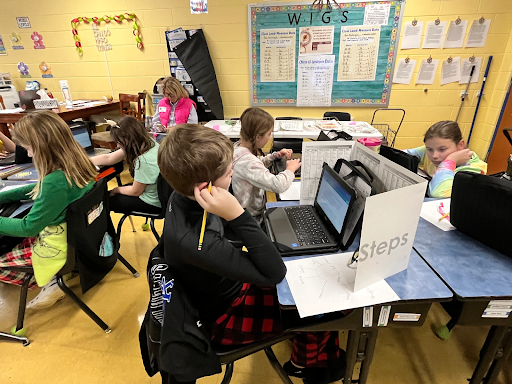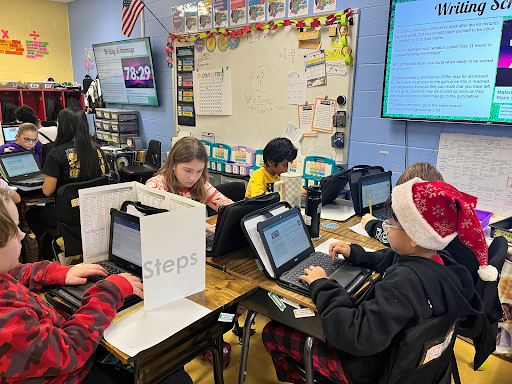While preparing students for a standardized test is not the main goal of education, teachers know that it is an important part of a student’s educational journey. No matter how well prepared students may be, test days can feel overwhelming and sometimes stressful! Too often, test results aren’t ready for several weeks, leaving students in the dark on their performance.
In Katherine Beals’ Kentucky elementary school, students experience the feeling of test day for a practice run, or a Writing Scrimmage. On this day, the tone – and schedule – changes so students can experience what to expect on actual game day, and work through any nerves or confusion that may come up. Notably, it’s not just the writing teachers who run their writing scrimmage! Volunteers from across the community – parents, other teachers, even the principal and district administrators – spend the day as proctors, scorers, and on-the-ground coordinators. Best of all, students get real-time feedback and grading on their writing on the spot, facilitated by writing or non-writing teachers with the help of AI-powered tools within Writable.
In this interview and blog post, Katherine shares her school’s practice of writing scrimmages and unpacks how test preparation can prepare students for far more than a standardized test.
Athletes don’t usually hit their personal record on gameday. Neither do writers. For athletes, their best performance usually comes on a random Tuesday during a low risk practice. Or even in the backyard playing around with family. No one expects the athlete to produce their best in that moment, but boy is it special. Their masterpiece seems somewhat random. Will the stars all align again on gameday? Will they do this again when it’s the last two minutes of the championship? Statistically… no. It’s important to know that human athletes are being impacted by so many internal and external factors on any given day, it’s rare they reproduce a personal record on the perfect day at the perfect time.
How does this same principle translate to writing? If you consider state-testing, a college application, or an on-demand final exam piece as “game day,” it’s pretty clear that it’s unlikely for students to produce the best writing on the right day at the right time.
For that reason, teachers (for the sake of the analogy, we can interchangeably use the term “coaches”), must equip their students to have an everyday performance worthy of a first-place trophy. It’s their everyday, run of the mill performance that is most likely to shine through, even in spite of the pressures of gameday. How do we as teachers , equip students with an average performance that is actually gameday worthy?
“Teachers must equip their students to have an everyday performance worthy of a first-place trophy.” -Katherine Beals
First, we must do what good coaches do: watch the film. We reproduce gameday: the hype, the pressure, the environment- we replicate it all for students. Although this is an exhibition game, or scrimmage (or “dress rehearsal” if you’d like to go with a more artistic analogy) that doesn’t technically “count,” you have produced an environment that feels very real to your students. This is why our students participate in the writing scrimmage. We do our best to imitate what they will experience on gameday, to see what students are able to produce. And, man, do they buy into it! How do I know? They are quick to confess their nervousness to me… a mix of emotions in their belly. Even though you tell them it doesn’t technically count, we’ve made it feel so real. So much so, I have to flood them with a locker room type speech beforehand, and tons of encouragement throughout.

Why does it matter? What they produce is, metaphorically, the “film” we will be watching for the next few months of school. (If you aren’t a sports person, coaches and teams typically watch their games on film to analyze their performance and make improvements to their plays.) Where are our weak points as a class? As a grade-level? As an individual? Which students still need significant training, which students are already rising to the top as a “Student coach”? In fact, here I sat down with a student with his writing scrimmage piece. After reviewing the “film” with me, he reported he felt disappointed over some of the mistakes he made. Him and I both knew his past pieces were stronger. But you know what that “film review” did? A little later that day, he asked me if he could fix his piece and really show what he can do. That, teachers, is an athlete ready to train.

Second, good coaches use analytics. You’ll notice that good coaches don’t rely on their experience and past success, all of which are clouded by all the human factors that go into our work. My energy, time, and ability to recognize patterns across 100 pieces after teaching all day is lacking. Additionally, I’ve only taught writing for 4 years. There is a lot I still don’t know as a writing teacher. Thankfully, I rely on Writable as my personal analytics coach. After the writing scrimmage, I turn to Writable AI and insights to determine what our team (class) needs. This year, one of my teams (classes) as a whole is focusing on strong conclusions that restate the main ideas and summarize key points. Additionally, Writable has reported low rubric scores on formatting quotations, voice, and transition words. In Writable, I can generate n personalized lesson plans and plan out our “playbook” for the next two months. These are the 5 areas in which we will train hard for this specific class.
Writable Insights pinpoints clarity and organization for my second class in the same way. As I scan through their papers, it’s interesting to see how much stronger this class’s conclusions are than the conclusions in class 1. How did this happen? I was the teacher for both of these classes? This is exactly why I need an analytics coach. When I click “view skill instruction,” writable gives me a plan to follow to target this, even suggesting specific students’ pieces to pull to use as models. Thank you, insights, for uncovering a clear blind spot.
Individually, Writable AI insights show me which specific students are “on watch” for which specific rubric items. This is what I used to create small group writing conferences. For example, Writable flagged 2 students who need coaching on creating an engaging hook. I will either pull them myself if I find the instructional time, or I will pair them with two students that Writable flagged as excelling in this area. On my own, finding this pattern, developing a lesson plan, scanning for students’ samples, and making this instructional decision would have taken several planning periods. With insights from Writable, I made this plan in 2 minutes and 48 seconds.
Rinse and repeat for all four of my writing classes.
For your students, “watching the film” for the writing scrimmage floods your kids with good feedback. For you as a coach, using Writable AI and analytics floods YOU with good feedback. This is a combination that will create championship level writers. You and your kids won’t be praying for a “PR” when the pressures are on. Instead, their average, everyday predictable performance will be championship worthy.
We previously spoke with Katherine and her colleague, Alicia Meador, about building confident readers and writers. Watch the webinar here.
Want to learn from more educators like Katherine who are using AI insights to supercharge their teaching? Join the Writable Educators Community on Facebook. Or, catch Katherine’s session at ISTE 2025 in San Antonio, TX where she’ll discuss her teaching practices with AI and share more about empowering all educators to be writing teachers.



